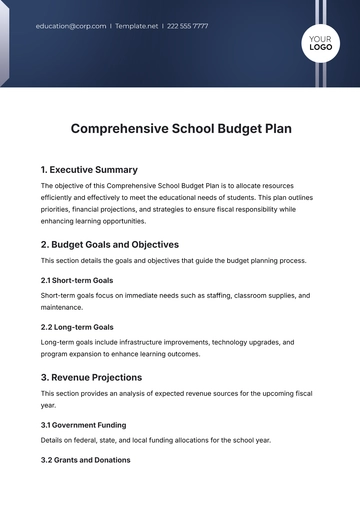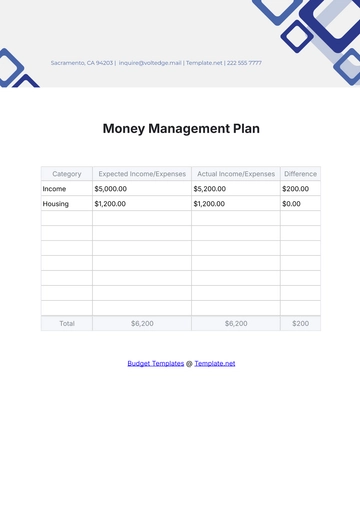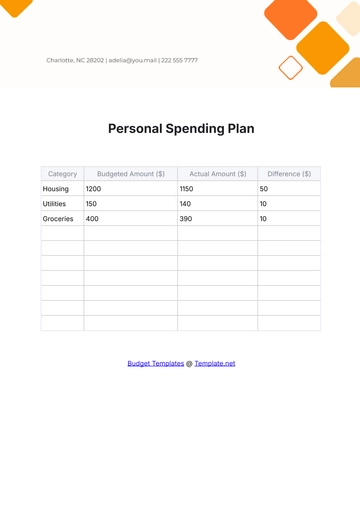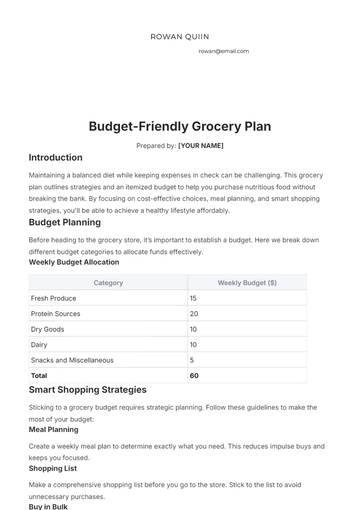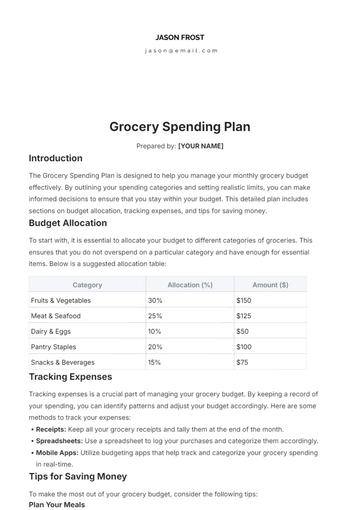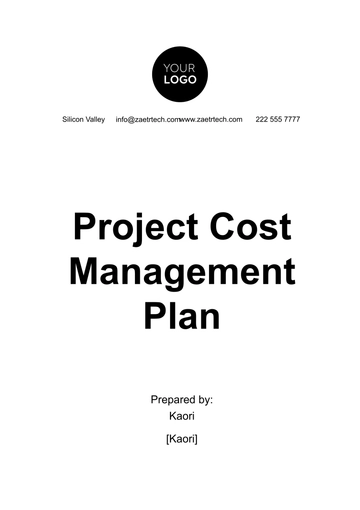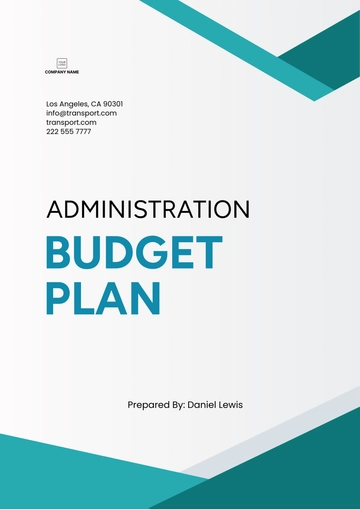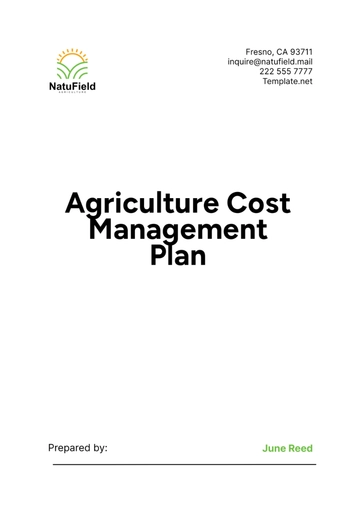Free Annual Financial Strategy Plan

TABLE OF CONTENTS
I. Executive Summary
II. Financial Situation Analysis
A. Current Financial Position
B. Performance Review
III. Revenue Enhancement Strategies
A. Revenue Streams Identification
B. Growth Opportunities
C. Pricing Strategy
IV. Cost Management and Efficiency
A. Expenditure Analysis
B. Budget Allocation
C. Investment Strategy
V. Risk Management and Mitigation
A. Risk Identification and Analysis
B. Mitigation Strategies
VI. Monitoring and Performance Evaluation
A. Key Performance Indicators (KPIs)
B. Regular Financial Review
I. Executive Summary
The Annual Financial Strategy Plan for [Your Company Name] serves as a guiding framework for our financial operations in the upcoming year. It is crafted to ensure that every fiscal decision and action taken aligns with our overarching aim of achieving sustainable growth and solidifying our financial footing. The plan encompasses strategies covering revenue enhancement, cost management, investment, and risk mitigation.
Summary of Strategic Financial Goals
For the forthcoming fiscal year, [Your Company Name] has set ambitious yet attainable financial goals. Aiming for a [15%] increase in overall revenue, our focus will be on tapping into new markets, enhancing product lines, and optimizing sales strategies. Concurrently, a targeted reduction in operational costs by [10%] is planned, which will involve streamlining processes, adopting cost-effective technologies, and renegotiating supplier contracts.
Moreover, sustaining a net profit margin of [20%] is crucial to our strategy, underscoring our commitment to efficient operations and prudent financial management. These goals are not just financial targets but are pivotal in driving our business towards greater market expansion, operational improvements, and ultimately, in maximizing shareholder value.
II. Financial Situation Analysis
This section provides a thorough analysis of [Your Company Name]'s current financial position and a review of the previous year's financial performance. It aims to offer a clear understanding of our financial health and identify areas that require strategic adjustments.
A. Current Financial Position
Currently, [Your Company Name] has a strong balance sheet with healthy cash reserves and manageable debt levels. Our asset portfolio is diversified, reducing financial risk exposure.
Financial Aspect | Details | Impact/Remarks |
|---|---|---|
Cash Reserves | $2 million | Sufficient liquidity for short-term operations |
Debt Levels | ||
Asset Portfolio | ||
Credit Rating | ||
Working Capital |
B. Performance Review
The previous year's financial review shows steady revenue growth, particularly in our digital services division. However, there were increased expenses in logistics and supply chain management, highlighting areas for improvement.
Financial Metric | Budgeted | Actual |
|---|---|---|
Total Revenue | $5,000,000 | $5,300,000 |
Total Expenditures | ||
Net Profit | ||
Sales Growth | ||
Cost Efficiency |
III. Revenue Enhancement Strategies
This section delves into [Your Company Name]'s strategies for enhancing revenue. It includes an analysis of our current revenue streams, identifies areas with growth potential, and outlines our approach to pricing strategies, aiming to maximize revenue while adapting to market demands.
A. Revenue Streams Identification
Primary revenue streams include product sales, service fees, and online subscriptions. Potential new streams are identified in emerging markets and through expanding our e-commerce platform.
Revenue Stream | Current Contribution | Potential for Growth | Strategies for Enhancement |
|---|---|---|---|
Product Sales | 40% of total revenue | High | Expand product lines, enter new markets |
Service Fees | |||
Online Subscriptions | |||
Licensing Revenue | |||
Emerging Markets |
B. Growth Opportunities
Market analysis suggests significant growth potential in Asian markets and in the adoption of AI-driven analytics services.
Market/Service Area | Projected Growth | Strategies for Exploitation | Expected Outcome |
|---|---|---|---|
Asian Markets | 20% annually | Marketing partnerships | Increased market share |
AI-Driven Analytics | |||
E-Commerce Expansion | |||
Green Technology | |||
Mobile Application Services |
C. Pricing Strategy
We will implement dynamic pricing strategies to optimize revenue from various customer segments, especially in competitive service areas.
Strategy | Application Area | Pricing Model | Expected Impact |
|---|---|---|---|
Dynamic Pricing | Online services | Adjust prices based on demand and customer data | Increase margins in peak demand periods |
Tiered Pricing | |||
Volume Discounts | |||
Promotional Offers | |||
Value-based Pricing |
IV. Cost Management and Efficiency
Effective cost management and efficiency are critical for [Your Company Name]'s financial health. This section discusses our approach to managing expenditures, allocating budgets, and strategizing investments to ensure optimal use of resources and maximizing returns.
A. Expenditure Analysis
Our in-depth expenditure analysis has identified significant areas for cost savings. In supply chain management, adopting lean inventory techniques and renegotiating supplier contracts can substantially reduce costs. Additionally, energy consumption is another major cost driver where savings can be realized.
By investing in energy-efficient technologies and optimizing usage patterns, we can significantly lower utility expenses. These changes not only reduce costs but also contribute to our sustainability goals, reflecting our commitment to responsible corporate practices.
B. Budget Allocation
The upcoming fiscal year's budget is strategically designed to focus on activities that yield high returns on investment. A significant portion is allocated to research and development (R&D) and digital marketing, areas that are crucial for innovation and market competitiveness.
We plan to minimize non-essential expenditures, such as travel and entertainment, and reevaluate all discretionary spending. This disciplined approach to budget allocation ensures that our financial resources are channeled into areas that drive growth and contribute directly to our strategic objectives.
C. Investment Strategy
Our investment strategy is focused on fostering long-term growth. We plan to allocate funds towards upgrading our technology infrastructure, which is pivotal in improving operational efficiency and enabling new digital capabilities. Market expansion initiatives, particularly in emerging markets, are also a focus area for investment. These strategic investments are expected to yield an average return on investment (ROI) of [15%] over the next two years.
V. Risk Management and Mitigation
Effective risk management is fundamental for [Your Company Name]'s financial stability. This section identifies key risks and outlines strategies to mitigate them, ensuring that the company is well-prepared to handle potential challenges.
A. Risk Identification and Analysis
Key risks include market volatility due to economic uncertainties and potential supply chain disruptions.
Risk Category | Likelihood | Impact | Key Indicators |
|---|---|---|---|
Market Volatility | High | High | Economic indicators, market trends |
Supply Chain Disruptions | |||
Currency Fluctuations | |||
Regulatory Changes | |||
Technological Changes |
B. Mitigation Strategies
Diversification of supply chain sources, and hedging against currency fluctuations will be crucial. Additionally, maintaining a contingency fund for unforeseen events is advised.
Risk Category | Mitigation Strategy | Implementation Approach |
|---|---|---|
Market Volatility | Diversification of product lines and markets | Enter new markets, develop varied product range |
Supply Chain Disruptions | ||
Currency Fluctuations | ||
Regulatory Changes | ||
Technological Changes |
VI. Monitoring and Performance Evaluation
This section outlines the key performance indicators (KPIs) that will be used to track progress and the regular review process to ensure ongoing alignment with our financial goals.
A. Key Performance Indicators (KPIs)
We have identified several KPIs critical to evaluating our financial health and strategic progress. Revenue Growth Rate will measure our success in expanding sales and entering new markets. The Expense Ratio will help us monitor our efficiency in managing and controlling costs. ROI on Investments will assess the effectiveness of our capital allocations, especially in technology and market expansion.
Finally, Customer Satisfaction Scores will provide insights into our market position and the impact of our services on client relations. These KPIs are selected to give a holistic view of our financial performance and market impact, ensuring we remain on a path to sustainable growth and profitability.
B. Regular Financial Review
Our financial strategy includes a rigorous schedule of quarterly reviews. These reviews will involve a comprehensive analysis of our financial statements, comparing actual performance against the planned budget and KPIs. This process will allow us to identify areas where we are excelling and areas needing improvement.
Based on these evaluations, we can make informed decisions to adjust our strategies, whether it's reallocating resources, revising revenue targets, or implementing new cost-saving measures. This regular and systematic review process ensures that our financial strategy remains dynamic and responsive to both internal performance metrics and external market conditions, thereby facilitating continuous improvement and adaptation.
Prepared by:
[Your Name]
[Your Company Name]
[Your Email]
- 100% Customizable, free editor
- Access 1 Million+ Templates, photo’s & graphics
- Download or share as a template
- Click and replace photos, graphics, text, backgrounds
- Resize, crop, AI write & more
- Access advanced editor
Craft your success strategy with Template.net's Annual Financial Strategy Plan. This editable, customizable tool is a game-changer for your fiscal insights. Editable in our Ai Editor Tool, it simplifies financial planning. Get a professional edge, ensure strategic precision, and watch your profitability grow. Superior planning starts here - your financial future never looked brighter.
You may also like
- Finance Plan
- Construction Plan
- Sales Plan
- Development Plan
- Career Plan
- Budget Plan
- HR Plan
- Education Plan
- Transition Plan
- Work Plan
- Training Plan
- Communication Plan
- Operation Plan
- Health And Safety Plan
- Strategy Plan
- Professional Development Plan
- Advertising Plan
- Risk Management Plan
- Restaurant Plan
- School Plan
- Nursing Home Patient Care Plan
- Nursing Care Plan
- Plan Event
- Startup Plan
- Social Media Plan
- Staffing Plan
- Annual Plan
- Content Plan
- Payment Plan
- Implementation Plan
- Hotel Plan
- Workout Plan
- Accounting Plan
- Campaign Plan
- Essay Plan
- 30 60 90 Day Plan
- Research Plan
- Recruitment Plan
- 90 Day Plan
- Quarterly Plan
- Emergency Plan
- 5 Year Plan
- Gym Plan
- Personal Plan
- IT and Software Plan
- Treatment Plan
- Real Estate Plan
- Law Firm Plan
- Healthcare Plan
- Improvement Plan
- Media Plan
- 5 Year Business Plan
- Learning Plan
- Marketing Campaign Plan
- Travel Agency Plan
- Cleaning Services Plan
- Interior Design Plan
- Performance Plan
- PR Plan
- Birth Plan
- Life Plan
- SEO Plan
- Disaster Recovery Plan
- Continuity Plan
- Launch Plan
- Legal Plan
- Behavior Plan
- Performance Improvement Plan
- Salon Plan
- Security Plan
- Security Management Plan
- Employee Development Plan
- Quality Plan
- Service Improvement Plan
- Growth Plan
- Incident Response Plan
- Basketball Plan
- Emergency Action Plan
- Product Launch Plan
- Spa Plan
- Employee Training Plan
- Data Analysis Plan
- Employee Action Plan
- Territory Plan
- Audit Plan
- Classroom Plan
- Activity Plan
- Parenting Plan
- Care Plan
- Project Execution Plan
- Exercise Plan
- Internship Plan
- Software Development Plan
- Continuous Improvement Plan
- Leave Plan
- 90 Day Sales Plan
- Advertising Agency Plan
- Employee Transition Plan
- Smart Action Plan
- Workplace Safety Plan
- Behavior Change Plan
- Contingency Plan
- Continuity of Operations Plan
- Health Plan
- Quality Control Plan
- Self Plan
- Sports Development Plan
- Change Management Plan
- Ecommerce Plan
- Personal Financial Plan
- Process Improvement Plan
- 30-60-90 Day Sales Plan
- Crisis Management Plan
- Engagement Plan
- Execution Plan
- Pandemic Plan
- Quality Assurance Plan
- Service Continuity Plan
- Agile Project Plan
- Fundraising Plan
- Job Transition Plan
- Asset Maintenance Plan
- Maintenance Plan
- Software Test Plan
- Staff Training and Development Plan
- 3 Year Plan
- Brand Activation Plan
- Release Plan
- Resource Plan
- Risk Mitigation Plan
- Teacher Plan
- 30 60 90 Day Plan for New Manager
- Food Safety Plan
- Food Truck Plan
- Hiring Plan
- Quality Management Plan
- Wellness Plan
- Behavior Intervention Plan
- Bonus Plan
- Investment Plan
- Maternity Leave Plan
- Pandemic Response Plan
- Succession Planning
- Coaching Plan
- Configuration Management Plan
- Remote Work Plan
- Self Care Plan
- Teaching Plan
- 100-Day Plan
- HACCP Plan
- Student Plan
- Sustainability Plan
- 30 60 90 Day Plan for Interview
- Access Plan
- Site Specific Safety Plan

